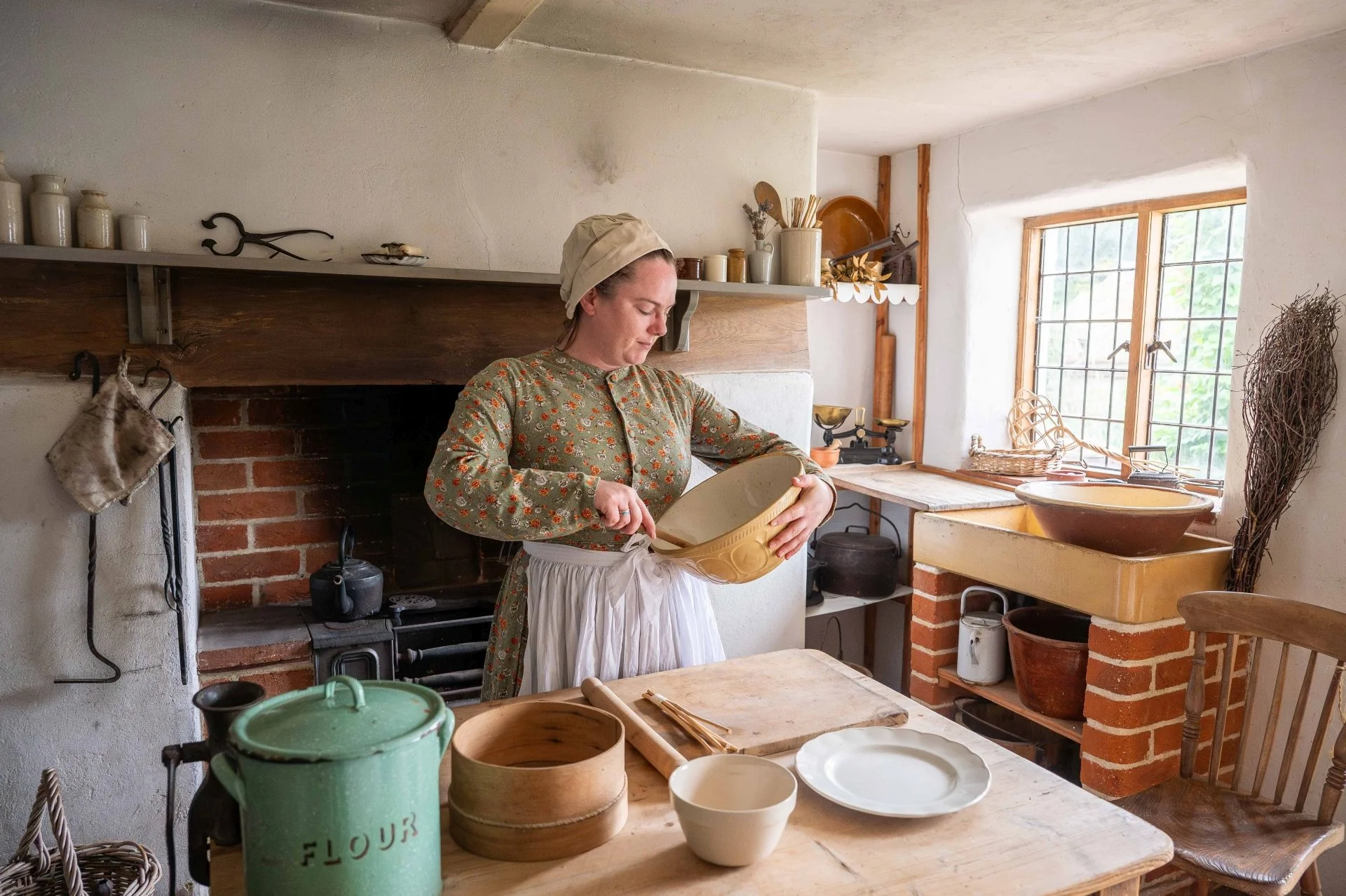Living Conditions Through the Years
Step back in time at Chiltern Open Air Museum and explore how home life and comfort have evolved through history. From the smoky Iron Age roundhouse and simple timber cottages to the Victorian wychert home and modern 1940s prefab, discover how living conditions changed over the centuries and what “comfort” once meant.
A costumed re-enactor shows what life was like in the Iron Age in the replica roundhouse at Chiltern Open Air Museum
In his book “At Home”, Bill Bryson writes: “…you could say that the history of private life is a history of getting comfortable slowly”. He points out that “comfortable” did not take on its present meaning until the 18th century. Before that it meant “capable of being consoled”. When we look at the living conditions of most people in the past we can see that comfort in our sense of the word just wasn’t possible.
Old dwellings may have provided protection of a kind, but there was little or no comfort. Take for example COAM’s oldest building, the Iron Age house, a replica of such a building from c. 1200 – c. 550 BC. In Western Europe, the Iron Age is generally considered as ending with the Roman conquest, the dates of which differ from one country to another. The floor of our replica Iron Age Roundhouse is made of rammed chalk and flint and the walls of a combination of hazel and ash, intricately woven between the main posts and split-oak intermediates. An outer layer of daub, composed of clay, mud, straw, and dung is added. The roof, re-thatched in 2012, is a substantial two-ton construction supported by wooden rafters. The roundhouse lacks a chimney and instead the hearth's smoke permeates through the thatch, leaving a protective tarry residue that contributes to the roof's preservation.
For many hundreds of years domestic buildings were usually made of wood and have therefore not survived until today. There are almost no such ancient buildings in the country, but there is one at 173, High Street, Berkhamsted where the timbers have been dated to the late 13th century. From the street a Victorian façade has hidden this fact. Another extraordinary neolithic village (3180 BC to 2500 BC) has been preserved at Skara Brae in the Orkney Islands.
At COAM the oldest domestic building is Astleham Manor Cottage which originated in the 1500s in Shepperton, Middlesex, as a three-bayed timber-framed hall house which is now used for the Museum’s offices. Leagrave is the next oldest, having begun as a barn in 1720 and adapted into two cottages in 1780. The level of “comfort” here is still low, but each family had its own space and the walls consist of a wooden frame covered in clapboards. What few possessions the family had would have been stored here and furniture would have been minimal, but they did have their own door, fire and bread oven.
A costumed re-enactor shows what life was like in Leagrave Cottage at Chiltern Open Air Museum
The comfort level improves immensely with the Toll House which was originally built in 1826 for the Collector of Tolls on the London to Oxford road at High Wycombe. It is a tiny house, but was home to a family of five in the 1840s. The walls are brick and it has a slate roof, a cooking stove, an indoor water pump and a laundry room with a boiler, but only one bedroom.
Next comes Haddenham Croft Cottage, a Victorian family home, crafted from wychert, a local material found in Buckinghamshire. Originating from the rare white earth near Haddenham, wychert is a composition of limestone, straw, and water, resulting in a concrete-like substance. (See en.wikipedia.org/wiki/Wychert for a fuller explanation.) Here we have a substantial family house with several fireplaces and three bedrooms, an indoor water supply, but no bathroom, hence the privies in the yard.
A costumed re-enactor in the Victorian kitchen in Haddenham Cottage at Chiltern Open Air Museum
The most modern dwelling in the Museum is the 1946 Prefab of which 156,623 were constructed between 1945 and 1951 when the programme officially ended. Built on a concrete base, with a steel frame and corrugated asbestos cement panels, they were originally built as a stopgap during a period of severe housing shortage. The prefabs eventually became permanent homes for thousands of people across Britain. Approximately 8,000 remain, still much appreciated by those who live in them. Our prefab has all the mod cons: running hot water, electricity, an indoor toilet and bathroom. In comparison to the other homes on site, it’s a palace.
Inside the comfortable living room in Amersham Prefab at Chiltern Open Air Museum
Thus we see that 1,400 years after the Romans left we are beginning to reach their level of sophistication – hot water, padded furniture and a feeling of security and comfort in our own homes. After so many years of putting up with really awful housing conditions the improvements came with a rush!




